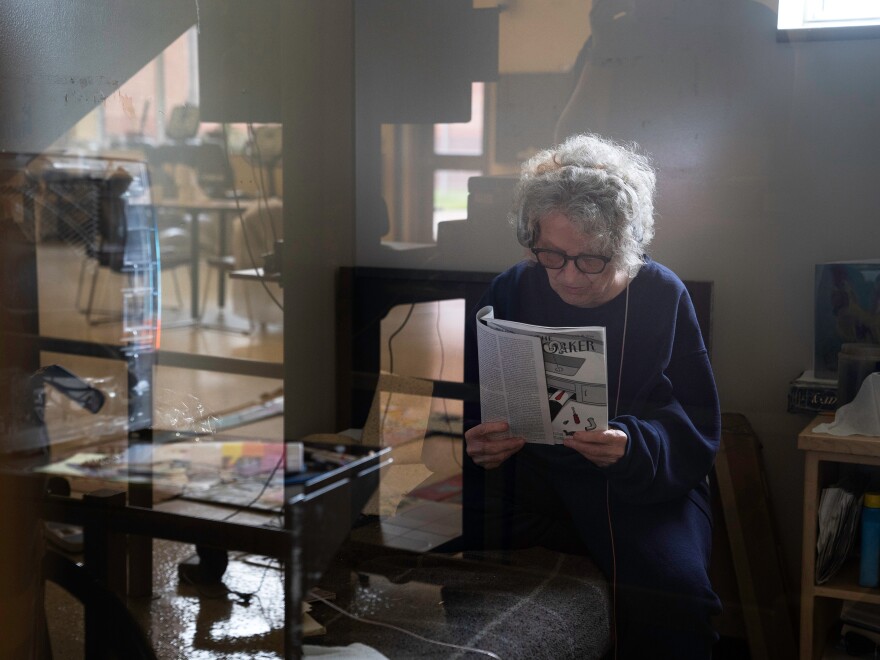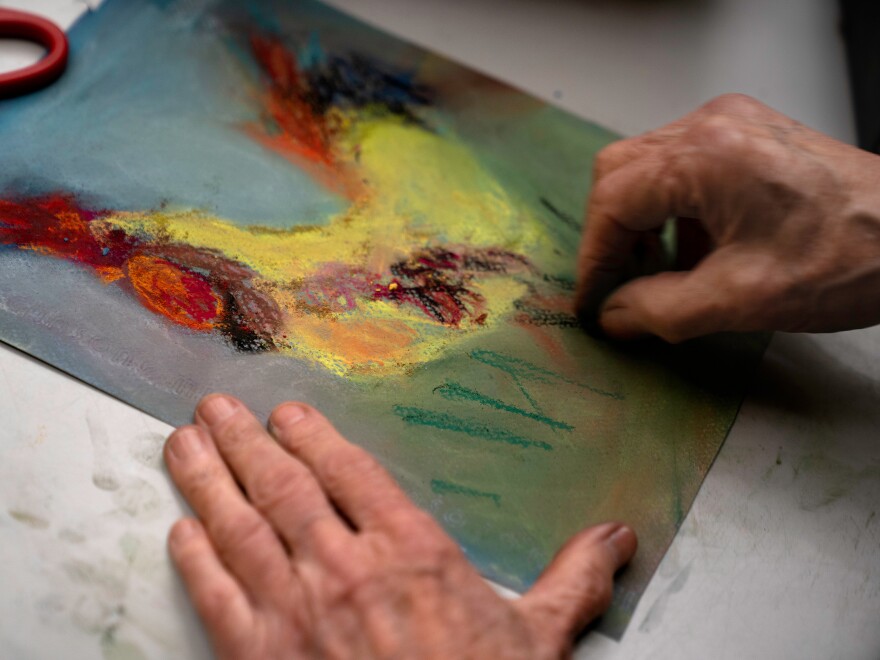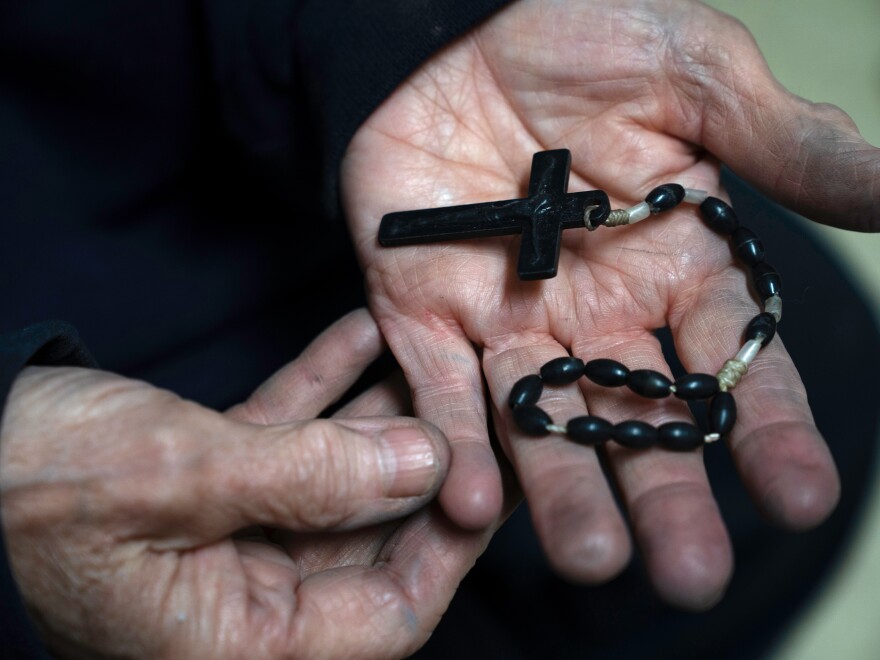The warden at the women's prison in Iowa recently instructed her corrections officers to stop giving out so many disciplinary tickets for minor violations of prison rules, like when a woman wears her sweatshirt inside out or rolls up her sleeves.
It's a small thing. But it's also part of a growing movement to reconsider the way women are treated in prison.
Called "gender-responsive corrections," the movement is built on a simple idea: that prison rules created to control men, particularly violent ones, often don't work well for women. That women come to prison with different histories from men — they're more likely to be victims of violence, for example — and they need different rules.
Something as trivial as an inside-out shirt? That could signify a gang affiliation in a men's prison. In a women's prison, the inmates might just like how it looks.
Loading...

At the newly built Iowa Correctional Institution for Women, Warden Sheryl Dahm has endorsed the idea. Every corrections officer there is getting trained in these differences.
"Having someone be authoritarian, or for lack of a better word, in power and controlling, is not what we want in here," Dahm said.
Officers are being trained to listen to prisoners more, give them more freedom — about how they wear their clothing — and to discipline them less.
Discipline is a focus of the new thinking because punishment designed for men often gets applied to women in unequal and harsh ways. That's the finding of an investigation by NPR and the Medill School of Journalism at Northwestern University. We found that women in prison are punished at significantly higher rates — often two to three times more often than men — for things that prisons classify as more minor violations of prison rules.
We collected data from men's and women's prisons in 15 states and found that women are more likely than men to be punished for infractions like talking back to, disobeying or cursing at a corrections officer.
Even citations for minor infractions can lead to significant punishments for women. They can get time added to their sentence or go to solitary confinement. They can lose privileges, including permission to see visitors or to use the phone. Those matter: Because women in prison, far more than men, are the caregiving parent for a minor child.
Loading...

"The punishment of women is more egregious than for men," says Kathy Tyler, a prisoner at the Iowa Correctional Institution for Women. And punishment for minor violations, she says, makes it hard for women to think they can change while in prison. "If you get disciplined, it insinuates that you're a bad person or that you're a rule breaker or you are not honorable."
The policy about rolling up shirtsleeves or wearing a sweatshirt inside out is an example.
"It's not gang related," said Dahm. "Women want to have control over how they look, about how they present themselves. ... Maybe she had a coffee stain."
Loading...

'I Thought I'd Seen It All'
Gender-responsive corrections is a concept that grew out of research into the paths women take to prison, and how those are generally different than for men. Many women come to prison for property and drug crimes. They commit fewer violent crimes than men and are less likely to use a gun. Additionally, some 75 to 90 percent of women in prison have been the victims of previous sexual or physical violence.
Dr. Jerome Greenfield, who runs health services for all of Iowa's prisons, says prison officials often underestimate the level of abuse in the lives of women before they get to prison. He left a psychiatry practice in Des Moines several years ago to first work as a staff psychiatrist on the mental health ward at the women's prison.
"Through the years of my practice, I thought I was a seasoned psychiatrist. I thought I'd seen it all," he says.
But when he came to work at the women's prison, "that's when I really saw and heard traumatic stories that were just beyond belief," Greenfield says. "I saw patients that had been chained for months at a time in a basement. Sold as property. Victims of Satanic rituals. But it goes even beyond that, because then in their homes, they were, many of them, beaten to the point of having traumatic brain injuries."
Many women coped, he says, by "using drugs at an early age. Methamphetamine. Heroin. Anything to dampen the anguish." And many developed serious mental illnesses.
A large percentage of men in prison and jail have been diagnosed with mental health problems, but the percentage is even higher among incarcerated women. Still, in prison, women are less likely than men to be violent.
Becki Ney, a pioneer of gender-responsive corrections, says the survival skills that help women outside prison walls may get them in trouble inside prison. When a corrections officer — especially if it's a man — gives a command in a harsh voice, or even grabs a woman, women are apt to react in a way that leads to discipline.
Loading...

"You may fight back. You may lash out. You may isolate. You may cut yourself," Ney said. "You may do a whole variety of things to survive, many of which are inappropriate behaviors inside prison."
The result is that women are disciplined for reacting in ways that most often are not violent, but break prison rules, like talking back or disobeying an order from an officer.
Iowa officials are changing some procedures to consider a woman's history of trauma. The prison has reduced the use of strip searches and changed the way searches are done, for instance. Now, a woman can choose to take off one garment, be searched and then put it back on. That allows her to avoid being completely naked in front of an officer.
Loading...

'I'd Rather Work With 10 Men Than With One Woman'
Ney, who started the National Resource Center on Justice Involved Women, says women also get in trouble for the way they interact with prison staff. "Men, if you tell them no, they just curse you. Then they walk away," Ney said. "A woman will say, 'Why?' And she'll keep asking."
"That's a generalization," Ney acknowledges, but she adds that a corrections officer will say: 'I'd rather work with 10 men than with one woman.' "
Corrections officers not trained in those gender differences will often ticket a woman who talks back. That's a big reason NPR's data show that women are ticketed often at two to three times the rate of men for offenses like insolence, disrespect or disobeying an officer.
About 15 states are trying gender-responsive practices in prisons, according to Ney.
In many states, gender-responsive practice may amount to just a few hours of training for corrections officers. In Illinois, new officers go through a six-week training academy. Officers assigned to one of the state's two women's prisons spend one week focused on how to deal with female prisoners. Other officers get a four-hour training. In Vermont, new officers go through five weeks of training, including four hours on female prisoners.
A study in Massachusetts, by the warden at the women's prison there, showed that when gender-responsive and trauma-informed practices were put in place, there was a decline in the issues that can lead to discipline, including inmate assaults on other inmates and prison staff.
Today, women make up about 7 percent of the nation's prison population. But since 1980, their numbers have skyrocketed, by more than 750 percent, according to federal statistics. That's largely the result of drug laws and mandatory sentencing.
And as more women end up in prison, there has been more research on women in prison.
Gender-responsive corrections came out of decades of that work — some of it back to the 1990s — by a small number of feminist sociologists, historians and other academics. It was pushed, too, by a small number of female consultants, like Ney, who specialize in corrections.
Another important group of proponents has been women who have made a career in corrections. They have long been a minority of corrections officials. Many started as officers and worked their way up.
Jennifer Sprafke started as a corrections officer in Vermont 18 years ago. "There were no women's uniforms," she recalls. "There were only men's sizes and I had never worn men's clothes. I had no idea what size pants I was supposed to get."
Today, Sprafke is the assistant superintendent of Chittenden Regional Correctional Center, the women's prison in Vermont, and she teaches gender-responsive practices to new corrections officers.
Loading...

Any woman who made a career in corrections very likely has stories of facing resistance, or hostility, from her male co-workers and bosses. Many say they stayed with it, in part, because they liked working with female inmates and felt those women were overlooked in corrections systems where the vast majority of inmates are men.
One result is that, today, record numbers of women are now in leadership positions in prisons and corrections departments across the country. In 13 states, women now run state corrections departments, according to the Association of State Correctional Administrators. That's an all-time high.
Many of them understand the need for new approaches, says Heidi Washington, director of the Michigan Department of Corrections.
"We still have one rulebook, one set of responses to misconduct behavior for men and women," she says. "And yet we know that women respond differently. We know that women have different experiences that bring them to prison."
Designing Prisons Specifically For Women
Iowa has made one of the most ambitious commitments to gender-responsive practices.
Every new officer at the Iowa Correctional Institution for Women is trained in gender-responsive practices that include lessons on how women respond to past trauma. All current staff, starting this month, are getting similar training.
Prisoners like Lucinda Gillam, who is serving time for robbery, are noticing the difference. Officers, particularly the new ones, Gillam says, "talk to us more; they interact with us more. They ask us how we're doing. Not trying to be our friend, but realize that we're people, although we've made mistakes to get ourselves here. You know, they're kinder."
Dahm, the warden, has a long history at the Iowa Correctional Institution for Women. She was a counselor and then later the deputy warden. She grew up in Mitchellville, the small town where the prison is located. Her mother worked at the prison as the business manager. The oldest inmate remembers Dahm as a young teen, sometimes tagging along with her mother.
Now 54, she has a tattoo on her wrist that reads, "forgiveness, grace and mercy."
"We're all human," she says. "That's what it reminds me of."
It is too soon to measure results from Iowa's new approach to incarcerating women. In 2016 — just before the start of new training for staff at this medium- and maximum-security prison — women here were punished for low-level violations of prison rules at higher rates than men. Women were almost three times more likely to be given disciplinary tickets for the violation of being "disruptive."
Some prison staffers welcome the change to gender-responsive corrections. Others say they've got more important problems — like not having enough corrections officers.
One staffer, who asked for anonymity for fear of getting in trouble, complained that the warden's new approach meant that, in her words, "the inmates are running the prison."
Dahm has heard that before, recently from a newly hired corrections officer.
"What she said is, 'You know, Warden, there's some people saying that the inmates are running the prison.' And I'm like, 'Well, they do. There's one of you to 96 women. So let's talk about how that looks. And how do we get the 96 to not cause problems. And what does that look like,' " Dahm said.
Tyler keeps a tall stack of magazines — issues of The New Yorker and Vanity Fair — in her cell. That's permitted now, but years ago, she was given a disciplinary ticket for keeping too many of these magazines. In her 40 years in prison, she is proud that she has never been cited for a major disciplinary ticket. But there were many minor ones: once for a missing towel, and another when she forgot the exact time she signed up to use the phone and made her call 15 minutes early.
Loading...

Tyler, at 82 and in prison for a murder conviction, keeps her artwork — pastels of people, animals, birds' nests and landscapes — over her bed. In a box under her bed, she has a copy of her master's thesis, on characters in Shakespeare, that she completed from prison.
And while Tyler, Gillam and other female prisoners appreciate that they are more respected under the new system, it is sometimes hard for them, too, to sweep aside their notions of what prison life is supposed to be. Tyler wishes the women who keep talking during prison church services would get tickets. Gillam worries that other inmates, without stricter guidelines, are unmotivated and don't take advantage of education and work opportunities that could help them once they leave prison.
One thing that helps Iowa implement gender-responsive policies: The prison architecture itself is different, designed specifically for women. The result is a place that resembles a college campus. Inside the razor wire, there are airy buildings connected by concrete pathways. There are landscaped gardens, including a "children's garden" for women to bring their children when they visit. There's a visitation center, with a large play area with dolls, toys and books.
Loading...

Loading...

The psychiatric unit, too, was designed to be different. There are still solitary confinement cells, but fewer women now end up in them. On the new unit, women are free to walk about the large common room with therapy dog Bella, a towering Great Dane, and cats. There are TVs, an elliptical machine facing a window, a garden and lots of natural light.
Gender-responsive corrections doesn't need a newly built prison like the one in Iowa to work, but it takes new thinking. The goal, says Dahm, is to make prison a place where women change and then are equipped to return to their communities.
"We really want to help build a woman up to be a strong woman," she says. "And to be able to guide her own way out into society."
This story was reported in collaboration with NPR, The Social Justice News Nexus at Medill School of Journalism at Northwestern University and The Chicago Reporter. Additional reporting by Chicago-based freelance reporter Jessica Pupovac; Kari Lydersen and Sydney Boles of Medill University School of Journalism; and Barbara van Woerkom of NPR. Data analysis by Pupovac, Robert Benincasa of NPR and Matt Kiefer of The Chicago Reporter.
Copyright 2025 NPR


